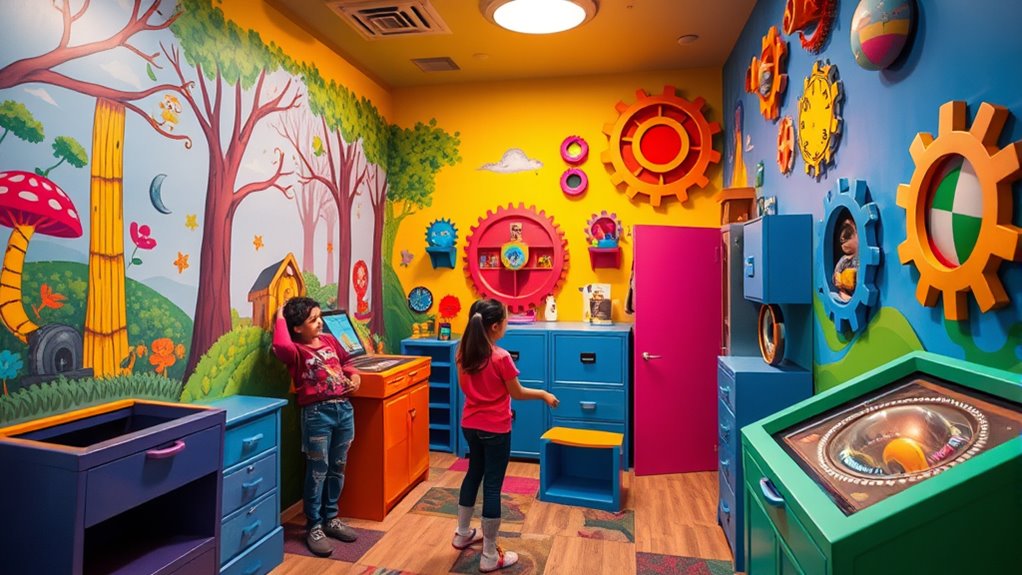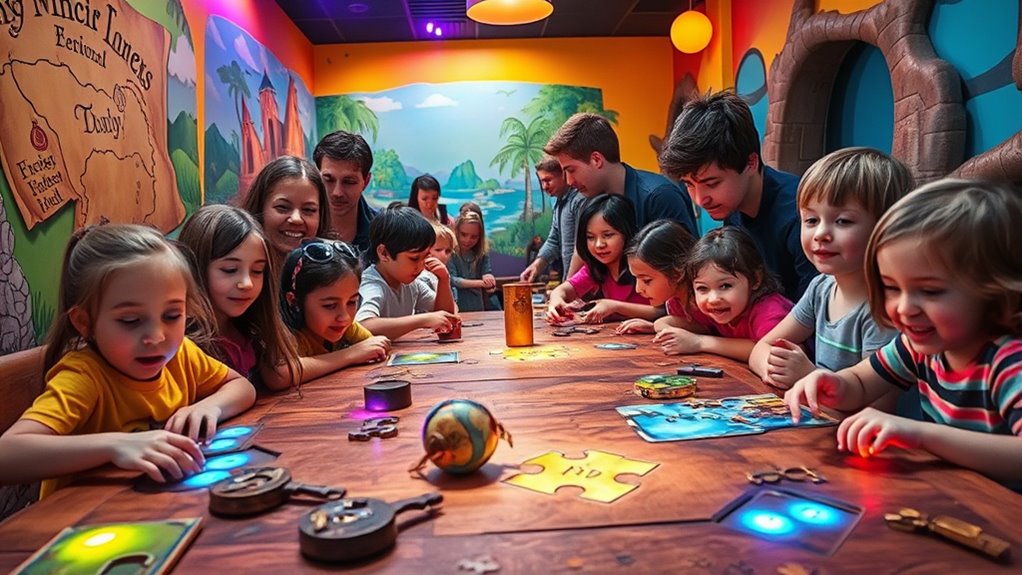When designing escape rooms for children and families, focus on creating engaging, age-appropriate puzzles that combine visual elements, simple logic, and physical activities. Use bright colors and familiar themes to spark curiosity, while ensuring all props are safe, durable, and child-friendly. Clear layouts and easy-to-understand clues help maintain safety and fun. To build a memorable experience that’s both safe and exciting, explore how to balance adventure with protection in the next section.
Key Takeaways
- Incorporate age-appropriate, interactive puzzles that stimulate curiosity and promote problem-solving skills for children and families.
- Use bright colors, familiar themes, and tactile elements to enhance engagement and sensory exploration.
- Ensure all props and decor are made from non-toxic, child-safe materials with secure, sturdy construction.
- Design clear, unobstructed layouts with safe, easily accessible exits to facilitate supervision and quick evacuation if needed.
- Balance fun and safety by integrating physical activities with safety protocols to create a secure, enjoyable adventure for all ages.

Have you ever wondered what makes an escape room fun and engaging for children and families? The secret lies in carefully designing experiences that challenge young minds while guaranteeing everyone feels safe and comfortable. When creating escape rooms for kids, interactive puzzles are essential. These puzzles should be age-appropriate, stimulating curiosity, and encouraging teamwork. Instead of overly complex riddles, focus on activities that involve physical interaction, pattern recognition, or simple logic. For example, matching shapes, decoding colorful symbols, or assembling straightforward puzzles can keep children engaged without frustrating them. These interactive elements help maintain a lively pace and make the experience memorable. Incorporating child-friendly materials ensures safety and durability in your design. Safety considerations are just as critical as the puzzles themselves. Children are naturally curious and energetic, so designing the space with their safety in mind is non-negotiable. You need to ensure that all furniture and decor are sturdy and free of sharp edges or small parts that could pose choking hazards. The layout should allow for easy supervision, with clear sightlines so adults can monitor children at all times. Avoid high or unstable objects that could cause falls, and make sure exits are clearly marked and unobstructed. Additionally, use non-toxic materials for any props or decorations, and keep the environment well-lit to prevent accidents. It’s also wise to incorporate safety protocols, like having first aid kits nearby and staff trained to respond quickly if needed. Creating a kid-friendly escape room involves balancing fun and safety seamlessly. When designing interactive puzzles, think about how children think and play. Use bright colors, familiar themes, and tactile elements that invite exploration. At the same time, always prioritize safety by double-checking that every element is secure and suitable for children’s use. The goal is to foster a sense of adventure while giving parents peace of mind. By combining engaging puzzles with thoughtful safety considerations, you craft an experience that’s both exciting and secure for kids and their families. This approach not only makes the activity enjoyable but also ensures parents trust your space as a safe environment for their children to learn, grow, and have fun.
Frequently Asked Questions
How Can Escape Rooms Be Adapted for Very Young Children?
You can adapt escape rooms for very young children by creating simple, interactive puzzles that are easy to understand and solve. Incorporate themed decorations to make the experience engaging and visually stimulating. Use tactile elements like soft puzzles or colorful objects to keep their attention. Keep the challenges short and fun, ensuring they’re age-appropriate and encourage teamwork, making the adventure enjoyable and safe for little ones.
What Safety Measures Are Essential in Children’s Escape Rooms?
You should prioritize child supervision and establish clear emergency protocols to guarantee safety. Constant adult oversight helps prevent accidents, while well-communicated procedures ensure quick responses if issues arise. Verify that all escape room elements are safe, non-toxic, and age-appropriate. Regular safety drills and accessible exits reassure both children and guardians, reinforcing the idea that safety isn’t just a rule but a crucial part of the experience.
How Do You Balance Challenge and Fun for All Age Groups?
You balance challenge and fun by customizing difficulty levels for each age group and using engagement strategies that keep everyone invested. Incorporate puzzles that vary in complexity, so younger kids stay entertained while older participants face more challenging tasks. Keep the atmosphere lively with colorful visuals, interactive elements, and teamwork opportunities. This approach guarantees all ages feel involved, motivated, and enjoy the experience without feeling overwhelmed or bored.
What Themes Are Most Popular Among Children and Families?
You’ll find that fantasy adventures and pirate quests top the list of popular themes among children and families. In fact, studies show that over 60% of young players prefer immersive, story-rich experiences. These themes ignite imagination, encourage teamwork, and keep everyone engaged. By incorporating elements like treasure hunts or magical worlds, you create memorable challenges that appeal to all ages and make your escape room an irresistible adventure.
How Can Escape Rooms Promote Teamwork Among Kids?
You can promote teamwork among kids by designing escape rooms that include team building exercises and collaborative puzzles. Encourage kids to communicate, share ideas, and work together to solve challenges. Use puzzles that require input from multiple players, fostering cooperation and problem-solving skills. By creating tasks that depend on teamwork, you help children learn the value of collaboration, building stronger bonds and enhancing their social skills in a fun, engaging environment.
Conclusion
Creating escape rooms for children and families is like crafting a treasure map—every clue and challenge guides participants toward a shared goal. I once watched a family work together, laughter filling the room as they solved puzzles side by side. Just like explorers on an adventure, your design fosters teamwork, fun, and discovery. When you make the experience engaging and accessible, you turn an ordinary day into an unforgettable journey that brings everyone closer.









